Avatar the Last Airbender Aang Avatar the Last Airbender Environment Concept Art
![]()
Avatar: The Last Airbender—The Art of the Blithe Serial is an artbook based on the blithe series Avatar: The Last Airbender. The volume contains concept fine art, blueprint works, behind-the-scenes commentary by serial founders Michael Dante DiMartino and Bryan Konietzko, along with other pieces of production artwork.[2] The volume was released in comic book stores on May nineteen, 2010 and in general bookstores on June 2, 2010. It consists of 184 pages, split into 5 chapters of the aforementioned material, nigh of which had never been revealed to the public before.[1] [ii] [4]
A second edition of the artbook was released on Nov 25, 2020, in a standard and deluxe edition, featuring a new cover by Bryan Konietzko, eight pages of new material and an updated foreword by Cistron Luen Yang. The deluxe edition likewise includes a designed slipcase, an art lithograph, a golden front encompass, and a ribbon marker.[3] [5]
Contents
- 1 Contents
- 1.1 Chapter One: Early development
- 1.2 Chapter Ii: Flavour Ane: H2o
- one.three Chapter Three: Season Two: Earth
- 1.4 Chapter Iv: Season Three: Fire
- 1.5 Affiliate Five: Coincident fine art
- 2 References
- 3 See besides
Contents
The book contains 5 chapters:
- Early evolution (pages viii through 37)
- Season One: Water (pages 38 through 83)
- Season Two: Globe (pages 84 through 129)
- Season Three: Fire (pages 130 through 172)
- Ancillary art (pages 172 through 183)
The first edition includes a foreword by the managing director of The Last Airbender, One thousand. Nighttime Shyamalan (page half dozen), while in the second edition the foreword was written by Factor Luen Yang, who authored the beginning 5 Avatar graphic novel trilogies. The book also includes an introduction by Avatar creators Bryan Konietzko and Michael Dante DiMartino (page seven). The very final folio contains a conclusion, which is over again written by the creators.
The book explains how the series was created and gives one an idea of the efforts that went into such an endeavor. Thanks to the many beautiful illustrations, the book also lets the reader get a step further into the deep World of Avatar.
Chapter 1: Early development
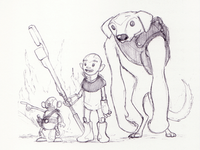
Early concept art of Aang, Appa, and Momo.
The pre- and early developmental stages were different to the series created. The two creators, Bryan Konietzko and Michael Dante DiMartino, brainstormed ideas on how to make an animation series, and not but made incredible progress with their dream to brand a idiot box prove, simply as well began a journey that would atomic number 82 them to a lifelong friendship. In the beginning, the show had a futuristic setting; Aang was non an Air Nomad from a hundred years ago, but rather a male child from a lost civilization from over a g years prior. He had a robotic sidekick named Momo-3, who afterwards became Aang's lemur Momo, and a bear-dog that, while non making it into the series' cut, later became the inspiration for Avatar Korra'south animal companion. According to Konietzko, Aang was originally "a farmer kid, shepherding mammoth floating livestock similar huge manatees ..." He also goes on to country the original idea behind the arrow was to get the herd to trust him through false. This idea was afterwards dropped, much to Bryan Konietzko'south dislike, equally there was no place for all of them in every episode. Nevertheless, they too played their part in the serial, having inspired the idea of Appa.
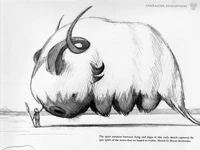
An early sketch of Appa and Aang to emphasise the "epic spirit of the series".
Every bit soon as the series had progressed to the point where Aang was going to be a child frozen in an iceberg for a hundred years, and the concluding hope for earth peace, the characters of Katara and Sokka were developed. Fifty-fifty though their designs at the time were even so unlike, Bryan and Mike both knew that Katara and Sokka were going to become a major part of the show.
According to the two co-creators, in the very commencement the Fire Lord was the only villain planned for the show. Soon however, Eric Coleman, one of the members of the Avatar team, suggested an thought which gave nativity to Zuko, the banished prince. With their idea finally ready, Bryan and Mike decided that it was time to brand the pilot.
Chapter Two: Season Ane: H2o
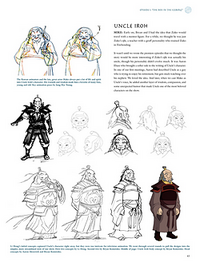
The page dedicated to Iroh.
After the pilot and the series were accepted by Nickelodeon, Bryan and Mike started recruiting a larger team to make the series. Later on succeeding in finding a studio in South korea, the team began piece of work on the two-episode season premiere. Iroh was added while making the offset episode; he was at first going to be Zuko's sifu, but later on on became his uncle to brand the story more personal. Co-ordinate to Bryan, Mako made Iroh's character consummate past calculation a sense of humor to the character.
At first, but thirteen episodes were scheduled past Nickelodeon, thus making "The Blueish Spirit" the last episode. However, Nickelodeon'south reaction to the thirteen episodes made was highly positive, and they let the show keep and expand. By the stop of the commencement flavour, the series had connected with a broad audition, both male and female person; the creators themselves admitted that they had never expected such a positive reaction and such a large audience.
Chapter Three: Flavour Two: Earth
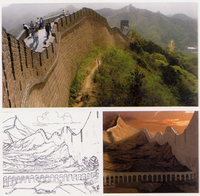
A visual comparing between the Bang-up Wall of Mainland china, and the Outer Wall of Ba Sing Se.
In forming the 2nd season, the creators traveled to Mainland china to proceeds inspiration - particularly the compages. Sites such as the Great Wall and the Forbidden City provided the scale used to inspire Ba Sing Se. After stumbling upon an architecture park, the duo found in an "inspirational goldmine", which happened to feature a vast array of Chinese architectural styles from a diversity of ethnicities and eras.
This affiliate shows several of these pictures, alongside the artwork from the series that was inspired by each ane. The influences of these images can be seen throughout the Globe Kingdom; the Great Wall tin can be directly related to the Outer Wall of Ba Sing Se.
The third chapter goes into some detail of the episodes of the second series; however, information technology likewise explains and elaborates on the designs and personalities of newly introduced characters, such equally Azula, Mai and Ty Lee, and Toph.
Chapter Four: Season Three: Fire

Storyboards of the energybending sequence performed by Aang on Ozai.
The fourth affiliate goes into some detail how the third and concluding series developed, from the introduction of new characters, such as Combustion Human and Hama, and the inspiration behind the unique landscape of the Fire Nation.
This chapter showcases a significant number of background sketches and drawings, from Piandao's castle, the Western Air Temple, Wulong Forest and Sozin's Comet, and the dusk over Iroh's tea store.
Burn Lord Ozai is too showcased, given several pages to show the unlike character designs during unlike parts of the flavour. Great item went onto explaining the four function finale, and how it transferred from the minds of the creators to the animation. Information technology features sketches of the lion turtle and Fire Nation airships, and the full sequence of Aang energybending.
Affiliate Five: Ancillary art
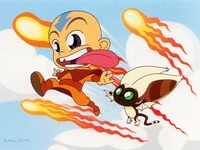
An early on example of the chibi-style artwork used in the Super Plain-featured Shorts.
The concluding affiliate features several additional pieces of artwork, such as promotional poster drawings, the DVD and book covers. A altogether card, fatigued by DiMartino for a girl who "wanted [him] to make Aang alive", and several caricatures of other storyboard artists are likewise shown. It also explains how the offset 'super deformed' (SD) version of the characters came to be and gives a detailed page of the different expressions used for the characters in the three shorts. In the second edition, a series of pages feature art fatigued to enhance charity funds during the COVID-nineteen pandemic. The finish of the affiliate is a simple thank-you note, acknowledging both their team and the reader.
References
- ↑ 1.0 1.one Avatar: The Concluding Airbender—The Art of the Blithe Series HC. Retrieved on July 25, 2020.
- ↑ 2.0 two.i 2.2 Comics Continuum: Nighttime Horse Comics for Apr. Retrieved on March 31, 2012.
- ↑ 3.0 three.1 Avatar: The Last Airbender—The Art of the Animated Series HC (Second Edition). Retrieved on July 25, 2020.
- ↑ rufftoon (May 19, 2010). It's a skillful week for Avatar fans.. LiveJournal. Retrieved on July 25, 2020.
- ↑ Penguin Random House: Avatar: The Final Airbender—The Art of the Animated Serial (Second Edition). Retrieved on July 25, 2020.
See also
- List of Avatar books
- The Legend of Korra: Enhanced Experience
- The Legend of Korra—The Art of the Animated Series, Volume 1: Air
- The Fable of Korra—The Art of the Animated Series, Book Two: Spirits
- The Legend of Korra—The Art of the Animated Series, Volume Three: Modify
- The Legend of Korra—The Art of the Animated Series, Book Four: Remainder
0 Response to "Avatar the Last Airbender Aang Avatar the Last Airbender Environment Concept Art"
Post a Comment